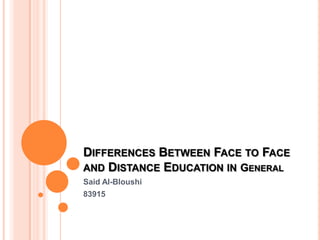Differences between face to face and distance education
•Download as PPTX, PDF•
0 likes•307 views
Report
Share
Report
Share

Recommended
To determine the relationship between performance in theoretical classroom instruction and related learning experience (RLE) of nursing students of WVSU.
Correlation between Theoretical Classroom Instruction and Related Learning Ex...

Correlation between Theoretical Classroom Instruction and Related Learning Ex...Ryan Michael Oducado
More Related Content
What's hot
To determine the relationship between performance in theoretical classroom instruction and related learning experience (RLE) of nursing students of WVSU.
Correlation between Theoretical Classroom Instruction and Related Learning Ex...

Correlation between Theoretical Classroom Instruction and Related Learning Ex...Ryan Michael Oducado
What's hot (19)
Learners’ perception of autonomy in blended programs

Learners’ perception of autonomy in blended programs
Student perspectives on formative feedback: an exploratory comparative study

Student perspectives on formative feedback: an exploratory comparative study
Information literacy education through mediated learning and multiple intelli...

Information literacy education through mediated learning and multiple intelli...
Correlation between Theoretical Classroom Instruction and Related Learning Ex...

Correlation between Theoretical Classroom Instruction and Related Learning Ex...
Effect of Multimodal Instructional Approaches on Students Learning of Chemist...

Effect of Multimodal Instructional Approaches on Students Learning of Chemist...
Similar to Differences between face to face and distance education
The purposes of this paper are to:
• Make more chemistry faculty aware of instructional applications of mobile devices
• Describe some of the current projects and create avenues for possible future collaboration.
• Become the first step towards creating a network of chemistry faculty who will share their successes (and failures) in using mobile phones and tablets to teach Chemistry.
The Mobile Chemistry Classroom Cooperative 

The Mobile Chemistry Classroom Cooperative US Environmental Protection Agency (EPA), Center for Computational Toxicology and Exposure
Similar to Differences between face to face and distance education (20)
Cornell Cooperative Extension Intern Presentations 2014

Cornell Cooperative Extension Intern Presentations 2014
Self-efficacy in Instructional Technology Contexts

Self-efficacy in Instructional Technology Contexts
Social media in medical education - final deck for acehp15

Social media in medical education - final deck for acehp15
Influence of School Rules' Formulation on Students' Discipline in Public Seco...

Influence of School Rules' Formulation on Students' Discipline in Public Seco...
Influence of School Rules' Formulation on Students' Discipline in Public Seco...

Influence of School Rules' Formulation on Students' Discipline in Public Seco...
Brief CommunicationTranslating evidence to practice in the

Brief CommunicationTranslating evidence to practice in the
Exploring student perceptions of health and infection: an interactive staff a...

Exploring student perceptions of health and infection: an interactive staff a...
Effects of multimedia instructional material on students learning

Effects of multimedia instructional material on students learning
Academic Misconduct What Students Think And A Few Case Studies

Academic Misconduct What Students Think And A Few Case Studies
Differences between face to face and distance education
- 1. DIFFERENCES BETWEEN FACE TO FACE AND DISTANCE EDUCATION IN GENERAL Said Al-Bloushi 83915
- 2. NO SIGNIFICANT DIFFERENCES Study title: “Effects of Traditional Classroom and Distance Continuing Education: A Theory-Driven Evaluation of a Vaccine-Preventable Diseases Course” Done By: Karl E. Umble, PhD, MPH Ronald M. Cervero, PhD Baiyin Yang, PhD William L. Atkinson, MD, MPH
- 3. Study objective: “This study evaluated the effects of a major federal immunization continuing education course, delivered in both traditional classroom and satellite broadcast versions, on public health professionals’ knowledge, agreement, self-efficacy, and adherence in practice to recommendations.” Study result: “Both versions significantly improved knowledge, agreement, self efficacy, and adherence. Knowledge and agreement were significant predictors of self-efficacy, which directly predicted adherence. Vaccine availability and supportive clinic policies were also important adherence predictors.”
- 4. SIGNIFICANT DIFFERENCES Study title: “THE EFFECTS OF WORLD WIDE WEB INSTRUCTION AND TRADITIONAL INSTRUCTION AND LEARNING STYLES ON ACHIEVEMENT AND CHANGES IN STUDENT ATTITUDES IN A TECHNICAL WRITING IN AN AGRICOMMUNICATION COURSE” Done by: Tina M. Day The Ohio State University Extension Matt R. Raven, Associate Professor Michael E. Newman, Associate Professor Mississippi State University
- 5. Study objective: “The purpose of this experimental study was to determine the effects of types of instruction and learning styles in a three-credit hour, technical writing in an agricommunication course on their achievement and attitudes towards writing, learning about writing, computers and the Internet. The two methods of instruction were traditional instruction without a laboratory and World Wide Web instruction with a laboratory.” Study result: “Students who were taught using the WWW with a laboratory achieved at a higher level than those students who were taught using the traditional classroom approach.”
